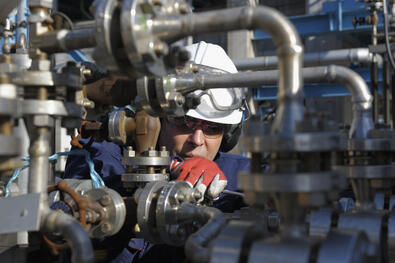Creating a Culture of Safety
In the energy industry, getting every worker home safely at the end of a shift is of critical importance. However, safety should be more than just the focus of a few designated roles within an organization. Instead, a successful safety program requires creating a culture of safety that permeates all departments and all levels of a company.
Oil & Gas organizations that embrace worker safety in a holistic way strengthen employee loyalty and build trusted relationships between workers and management, ultimately increasing productivity, helping attract and retain top talent, and reducing costly turnovers.
“When workers are getting hurt, it’s a sign that things aren’t going right,” says Dr. David Michaels, eight-year OSHA Assistant Secretary of Labor, whose work focuses on helping companies be “safe, productive, and profitable at the same time.”
Safety isn’t a discrete issue for energy companies: it’s a key performance indicator of an organization’s overall operational effectiveness.
In the following video, Dr. Michaels discusses the importance of embedding safety as part of an organization’s culture with five strategies to help get there:
Every department can integrate safety and harness the power of technology and data to achieve the highest possible levels of safety and operational efficiency.
Key Indicators of a Strong Safety Culture
When you take care of your people, your people will take care of you. Ask the following questions to determine if your company has a strong safety culture.
- Does your company’s leadership give a strong direction for your safety culture?
- Are employees involved in the process? Are they engaged, supportive and invested in the company’s safety program?
- Does your company embrace a culture of continuous improvement that regularly evaluates how safety can be improved further?
- Do you have a culture of accountability where staff look out for each other and hold each other accountable to keep everyone safe?
- Does your organization recognize and reward positive safety measures rather than punishing mistakes?
- And finally, is a safety focus ingrained in all departments in the company?
Many energy organizations may be able to check some of the boxes above, but there may be gaps in their safety program, they may lack the right data or technology to measure performance and inform decisions.
For a more in-depth look at the indicators of a strong safety culture, listen to this interview on the OH&S SafetyPod podcast.
Safety Requires the Right People and the Right Tech
Achieving a culture of safety requires the involvement of every department within an organization. However, even with every team on board, maintaining the highest levels of safety and efficiency is only possible by leveraging the right technology and data to inform smart decisions—from real-time decisions to long-term safety policy and procedure changes.
It is important to partner with a safety solution vendor that can not only supply the technology required to improve your safety but also serve as a trusted advisor throughout, and after, implementation. From cloud-connected devices that continuously monitor for safety incidents in real-time to quantitative data and insights dashboards, a comprehensive safety solution reveals opportunities to take safety to the next level.
The real key here is the power of data: every team throughout an energy organization can use data from connected safety devices to not only improve safety, but also to improve overall performance, increase efficiency, and save costs. Here are some examples by department:
Operations and Project Management
Operations and project management teams are at the forefront of the digital transformation to drive higher levels of safety, ensure operational efficiency, and reduce costly unplanned downtime. They are tasked with ensuring projects run smoothly, workers are where they are supposed to be, and roadblocks are resolved in a timely manner.
Downtime, in particular, is a key concern, as unplanned downtime of any duration can quickly amount to millions of dollars in financial damage. In fact, a Kimberlite study found that a 1% downtime rate, equal to 3.65 days annually, costs oil and gas companies more than $5 million per year.
“Operational Excellence is a requirement for success in today’s marketplace, and reducing unplanned downtime plays a critical role in that success.” – Leif Eriksen, GE Digital
To maximize uptime and minimize impacts to the bottom line, especially during shutdowns and turnarounds, operations teams require a solution that provides data and analytics for predictive (rather than reactive) maintenance and repairs. Predictive maintenance can use gas monitoring data to keep an eye on worksite readings and immediately identify changes in levels that are early indicators of a leak or other problem, allowing the issue to be resolved before it escalates to catastrophic failure and unexpected downtime.
A technology solution that leverages connected safety devices also decreases operating costs in other, simpler ways. For example, because devices are connected, teams can use GPS to locate where they left their detectors, saving the costs of replacing lost equipment and stocking large amounts of backup inventory.

Safety and Industrial Hygiene
Safety and Industrial Hygiene (IH) teams are responsible for recognizing and managing workplace hazards, as well as ensuring regulatory compliance throughout the organization. They need real-time awareness of safety and compliance data to measure performance against safety KPIs and ensure compliance with safety standards and regulations.
Safety and IH teams can use connected safety data and actionable insights from analytics dashboards to inform safety initiatives within an organization to reduce risk.
Beyond supplying the hardware and delivering the data and insights to make improved safety decisions, 24/7 live monitoring through a dedicated team of trained professionals focused exclusively on ensuring the wellbeing of employees’ safety ensures someone always has their backs.
The Blackline Live monitoring portal shows the comprehensive safety status of every team member at a glance on a live, real-time map, providing monitoring agents with critical insights into emergency alerts in real-time.
Emergency Management
Emergency management teams must also be equipped to effectively respond to fire and hazmat incidents and facilitate swift evacuations when needed. To do this, emergency response teams need gas detection hardware, along with the software, data, and communication capabilities to access real-time information about the incident and enable rapid and appropriate decision-making.
A comprehensive safety solution includes:
- Both area monitors and portable gas detectors for each responder at risk.
- Insights from both gives the ability to make data-driven decisions to protect workers, responders and the facility.
- Detectors can be used to create a monitoring perimeter around the incident to protect the surrounding area and neighborhoods.
- Gas detection data can be accessed and analyzed in real-time to drive critical decisions —now, not 10 minutes ago.
To achieve this, the ability to rapidly deploy area monitors and instantly connect personal gas detectors is critical. From there, the software solution must make the data available quickly and in a way that is immediately actionable. For example, the Blackline Live software interface clearly displays the exact location and status for each device in the connected safety network—instantly— on an intuitive dashboard.

Procurement and Instrumentation
Procurement and instrumentation teams are tasked with acquiring safety equipment, the software to support it and managing all aspects of its usage. Key priorities for them include contract terms, pricing, and budget, and ease of use. With many safety devices, the cost can be a major concern when many different specialized devices are needed, as well as backup inventory for devices that must be replaced on short notice when a battery dies or a sensor fails.
Look for a connected safety solution that combines multiple specialized devices into one. For example, the G7 all-in-one personal monitoring device incorporates gas detection, worker down detection, and two-way communications in a single, portable and rugged device. Each unit comes standard with a spare cartridge, so if a sensor fails, the user can simply switch out the cartridge rather than sending back the entire unit.
IT / Digital Transformation
Finally, IT and digital transformation teams need a technology solution that will make worksites safer without costly and time-consuming IT infrastructure changes. Many safety solutions require setting up MESH networks (that often limit the number of devices that can be connected) or ensuring a strong Wi-Fi signal throughout the facility, which can be a major challenge and add significant cost to deployment and maintenance.
Other connected safety devices, automatically connect to the cloud with cellular connectivity or satellite, reducing IT deployment time and troubleshooting connection issues. Satellite connectivity is especially critical for workers that visit job sites in remote areas where a cellular connection is limited. Equipped with personal monitoring devices that connect automatically from anywhere in the world means every worker can always be connected and always be safe.
With no software to install and device updates completed automatically with modern devices, there is no IT maintenance required after deployment – so each team can seamlessly and independently control their own safety.
Conclusion
For energy companies, safety needs to be a key focus for all departments, and it must be an integral part of the company’s DNA. Compliance alone is no longer sufficient. Every department must be involved in driving safety forward and finding new opportunities to bolster a safety ecosystem that gives workers confidence every time they start a shift.
Ultimately, safety is one of the most valuable use cases for industrial digital transformation; by using data, connected devices, and a connected workforce, oil and gas companies can both increase operational excellence and ensure that every worker gets home safely at the end of the day.
Read More Oil & Gas Resources from Blackline.
Share This:




 CDN NEWS |
CDN NEWS |  US NEWS
US NEWS 
























TOP 10 RELECTIONS on Information Technology Developments in 2025 – Yogi Schulz